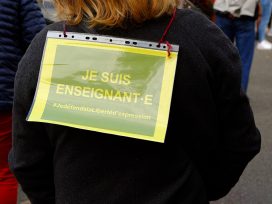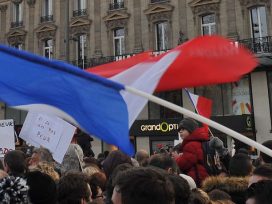Three years ago, Finnish public radio called me after a gunman killed five people at a school in Finland. I was asked why this happened in Finland and not in Norway, given that these two countries are so similar culturally, geographically and demographically. At that time it was hard for me to even speculate. Now I find my self in the other position, just as baffled: Is there something “extreme” in Norwegian society? In this well-functioning social-democratic society characterized by trust and equality?
The news that the terrorist who detonated a car bomb outside the Norwegian prime minister’s office and attacked a youth rally at Utøya outside Oslo killing 76 people, was Norwegian – and a “cultural conservative”, as he calls himself – has puzzled a Norway in shock and disbelief. We didn’t think we had right-wing extremists ready to act on their beliefs. Is he just a madman? A self-radicalized lone wolf? And why massacre young people from the AUF, the youth organization of the moderate, centre-left Labour Party?
Definite answers will probably never be reached. By definition, a person killing children in cold blood, at point blank, is a psychopath. The question we need ask ourselves is nevertheless if and how an increasingly aggressive political public debate can pave the way for such atrocious acts. What happens when the metaphors and allegories are taken literally?
One defining feature of Scandinavian politics is that the existing social-democratic system is so cherished by the population that all political parties embrace it, even the Right (earlier this year they even claimed they were as central in its creation as the workers’ movement). The racist Right – especially in Denmark, but also in Norway and Sweden – has embraced this model and see immigration, not the increasing inequality created by the neoliberal globalization or a gluttonous financial industry, as the main threat against it. This is further supported by the liberal Right’s doomsday-claim that the system is not viable (despite the facts to the contrary and that all polls show that a huge majority of Norwegians are willing to pay more taxes to keep the welfare system).
This discourse of the imminent fall of the social-democratic model is one central backdrop to the “cultural conservative” strain of right-wingers that Anders Behring Breivik is part of. It is important to pay close attention to the difference between the neo-Nazi movement and these “cultural conservatives”. In his online postings, Breivik doesn’t show any of the signs of the traditional racist extreme Right: he condemns Islam as a political ideology not Muslims as a biologically inferior race; he doesn’t promote crusades against the Islamic world (just against Muslims in Europe); he supports Israel and denounces historical Nazism. His main enemy is what he calls “cultural Marxists”, which basically covers everyone that speaks for multiculturalism, i.e. large parts of the political spectrum. In his “manifesto”, the basic idea is that Europe has been invaded by Islam. He uses demographics as a weapon and accuses the “cultural Marxists” of having sold out Europe. The “manifesto” is mostly a cut-and-paste work of different anti-Islam texts, mostly from English-language sources and some Norwegian. It is internally incoherent in a number of ways, but shows the urge to draw the “logical” conclusion of what he sees as a Europe in a state of war and/or occupation, and some kind of diffuse nostalgia for pre-1918 Europe. As most nationalists he doesn’t seem to know much about the history and culture he claims to defend.
However, Breivik’s writings are not the wild fabulations of a madman, but rather familiar. We have heard most of his views before, many times. They are not that far from those pronounced by the Norwegian Progress Party (FrP, which Breivik was a member of for six or seven years but ultimately left in the mid-2000s as he became more radicalized). It started as an anti-tax party in the 1970s, but evolved during the 1980s into Norway’s main xenophobic party. In the 1990s, the Progress Party rid themselves of the most radical elements and became a more or less accepted part of mainstream politics. After 9/11, the Progress Party has branded Islam as an inherently evil religion and legitimized racism against Muslims under the heading “critique of religion”.
In the 2009 election campaign, the leader of the Progress Party, Siv Jensen, launched the thesis of a “snik-islamisering”, a covert Islamization of Norwegian society. As she didn’t find any good examples in Norway she instead turned to Sweden, saying that the Malmö suburb of Rosengård was “overrun by Muslims” and “ruled by Sharia”. Metaphorically or literally? Just three months ago the up-and-coming “immigration sceptic” in the Progress Party, Christian Tybring-Gjedde, said in parliament that “the truth is that Islam is growing, and the values we stand for are disappearing in our country”, and that “you don’t find any dedicated Muslims that distance themselves from Sharia”. The “father” of today’s Progress Party, Carl I. Hagen (its leader from 1978 to 2006), said in a speech to a Christian group in 2004: “They [the Muslims] have, just like Hitler, mapped out a long time ago that their long-term plan is to Islamize the world.”
Even though the Progress Party nourishes (metaphorically) the idea of a Muslim invasion and conspiracy against Western Europe, it must be said that they are quite moderate compared to the Sweden Democrats, who won 20 seats in the Swedish parliament last year. Their leader, Jimmie Åkesson, have repeatedly called Islam the biggest threat to Sweden “since WWII”. This idea of a threat, or even an occupation, is also being purported in Denmark by the Danish People’s Party. It is Denmark’s third biggest party (13.8 per cent of the votes in the 2007 elections) and claims that Muslim immigration is “the largest national disaster” of the past decades, and does not hesitate to call to combat against this threat with allegorical (?) references to the Danish resistance movement during WWII.
This is just a few, rather moderate, examples of an overtly racist discourse that has become “normal” in mainstream European politics: French ministers speak of the necessity of defending “French identity”; both Germany’s and Great Britain’s prime ministers declared earlier this year that “multiculturalism has failed”, without bringing any further argument, just an implicit acknowledgement of the unfounded xenophobic claim that different cultures (i.e. Christians and Muslims) can’t live together. Not to speak of the Tea Party movement in the US that doesn’t hesitate to portray Obama as Hitler, while at the same time conjuring conspiracy theories with Obama as a Muslim infiltrator and demanding to see his birth certificate. What happens if people take this rhetoric, these metaphors, literally?
But the question remains: Why Norway? Why such an extreme act of hatred in a peaceful and safe country with little social tension, virtually no unemployment and a high degree of equality? It is, according to the UN, one of the best countries in the world to live in.
Even though the class differences in Norway are quite small in terms of income and culture, they are still there. In the last decade or two there has been a class re-composition, where we have seen working-class voters go from the social-democrat Labour Party to the populist, xenophobic Progress Party. The modalities of this shift is still an enigma, many on the left have tried to solve the “Progress Party code”. The most common explanation is the professionalization of the Labour Party, distancing their politicians from the people, while the Progress Party are more “folksy” and easier to identify with. The populists and parts of the liberal Right have, since the early noughties in Denmark and a little later in Norway, launched a “cultural battle” against the “political correctness” (a term Breivik often uses) of the Left. All major parties in Norway label themselves social-democrat, the system is so popular that speaking against it would be a recipe for electoral disaster, but the liberal Right and the more economic liberal parts of Labour have developed a consensus that the welfare system is not viable in the long term. The liberal Right uses this, of course, to argue for privatization of public services, while the populist Right, the Progress Party, puts the blame on the immigrants. So the combination of “folksy” identification and an easy explanation for complex economic problems might explain an increasingly xenophobic environment. This combines with the general acceptance of anti-Islam racism after 9/11. But again, this xenophobic environment is not particular to Norway.
The main enemy of Breivik – and other “cultural conservatives” – are not the Muslims, whose strong feelings of identity they respect, but the weak and “feminine” “cultural Marxists”, the proponents of multiculturalism. This explains why Breivik chose to attack the Labour Party and not a mosque or some other Islamic site or symbol. The argument is not new and can be found all over Europe: the Left are by their insistence on the white man’s imperialistic past denigrating the white man – it is racism in reverse, they claim. This is why Breivik insists that he is an anti-racist.
Breivik exhibits an enormous hate against the Norwegian centre-left. There is a social dynamics at play here that is hard to explain: Why did this man who grew up in the affluent western part of Oslo develop such hatred against mainstream politics? I don’t think we have enough facts, yet, to clearly separate the psychological elements from the social environment and the political context.
However, the “Marxist” component is not negligible. In the last few years, the liberal and conservative Right have aggressively highlighted the crimes of communism (Stalin and Pol Pot) equating Marxism with Nazism, the implicit argument being that even thinking about social change leads inadvertently to totalitarian regimes. This argument has often been used to accuse the Left of having a hidden agenda in order to disqualify their desire for a more just and equal society. This strategy has proved an effective means to block political debate on the socio-economic development of our societies, turning politics into “a cultural battle” rather than a debate on how to distribute wealth and bring people together.
All over Europe we see the same antagonisms that seems to be the political motivation behind Breivik’s acts. It is hard to determine what causes the passage à l’acte in such extreme cases as this, but if there is anything we can learn at this early stage it is that the normalization of racism and aggressive discourse in the public sphere can radicalize alienated people. The populist and xenophobic Right should not be blamed for these horrendous acts of terrorism, but the acts highlight the discursive responsibility we all have. Metaphors can be read literally. This is not a question of freedom of speech but of rhetorical honesty and responsibility.






